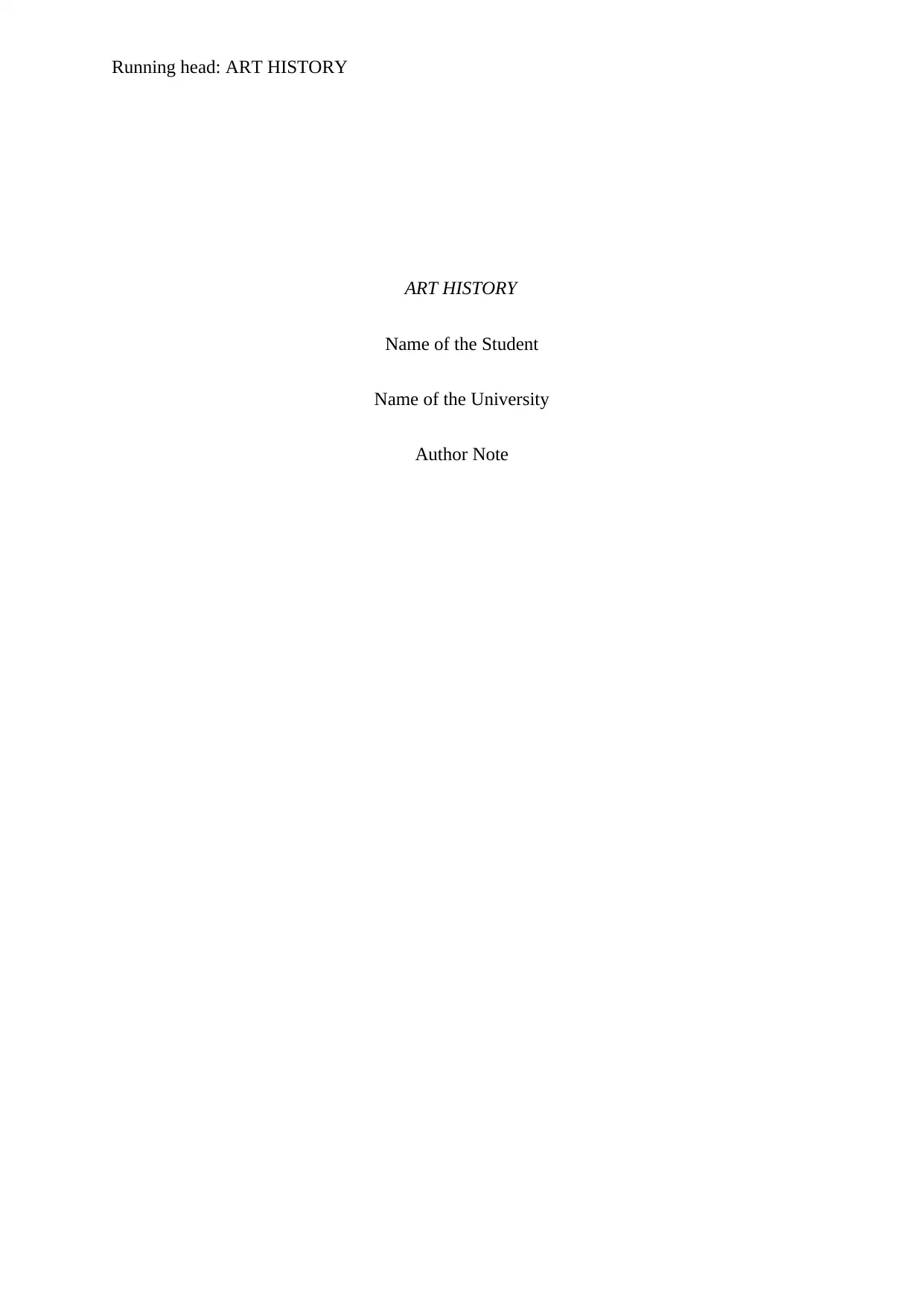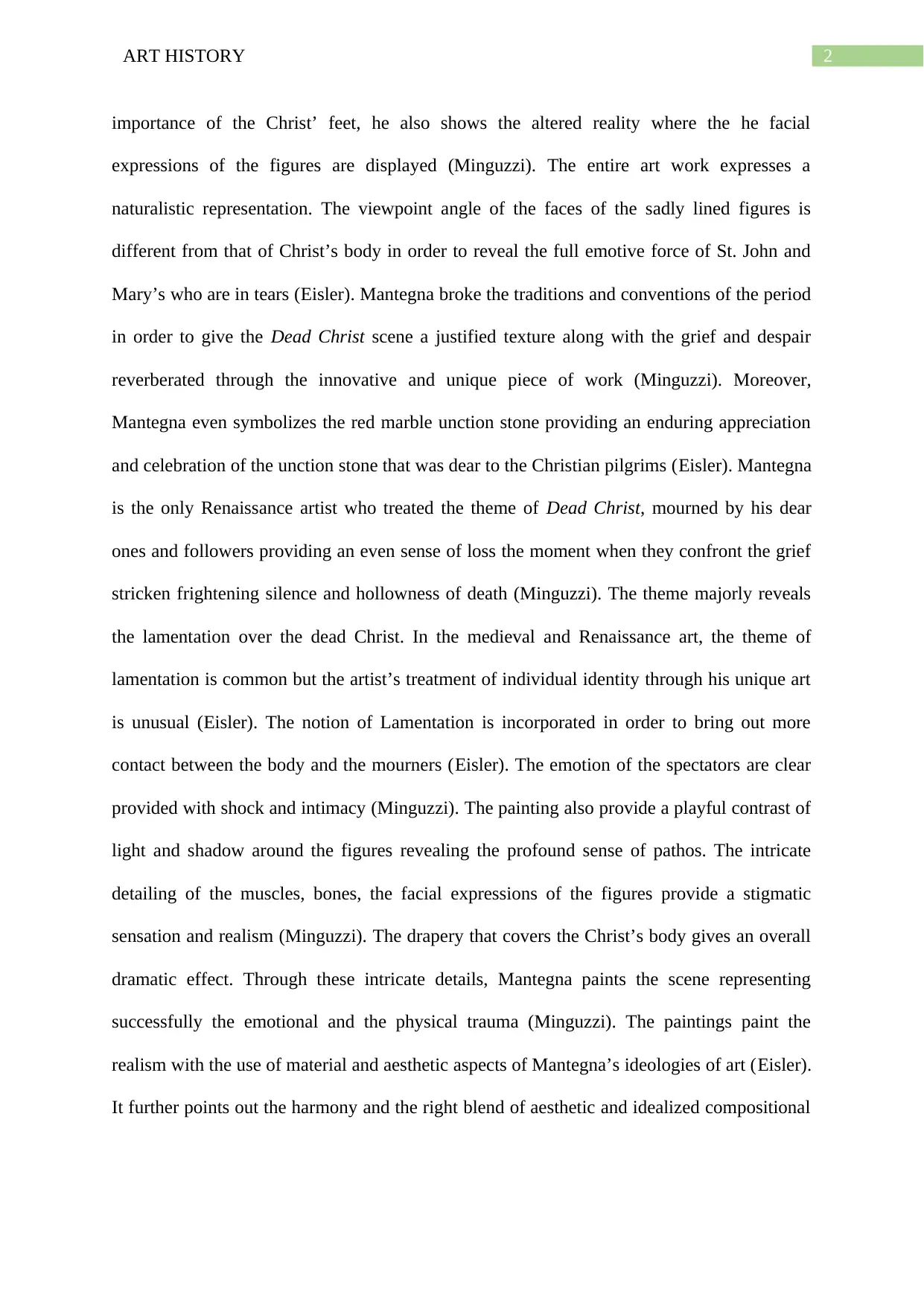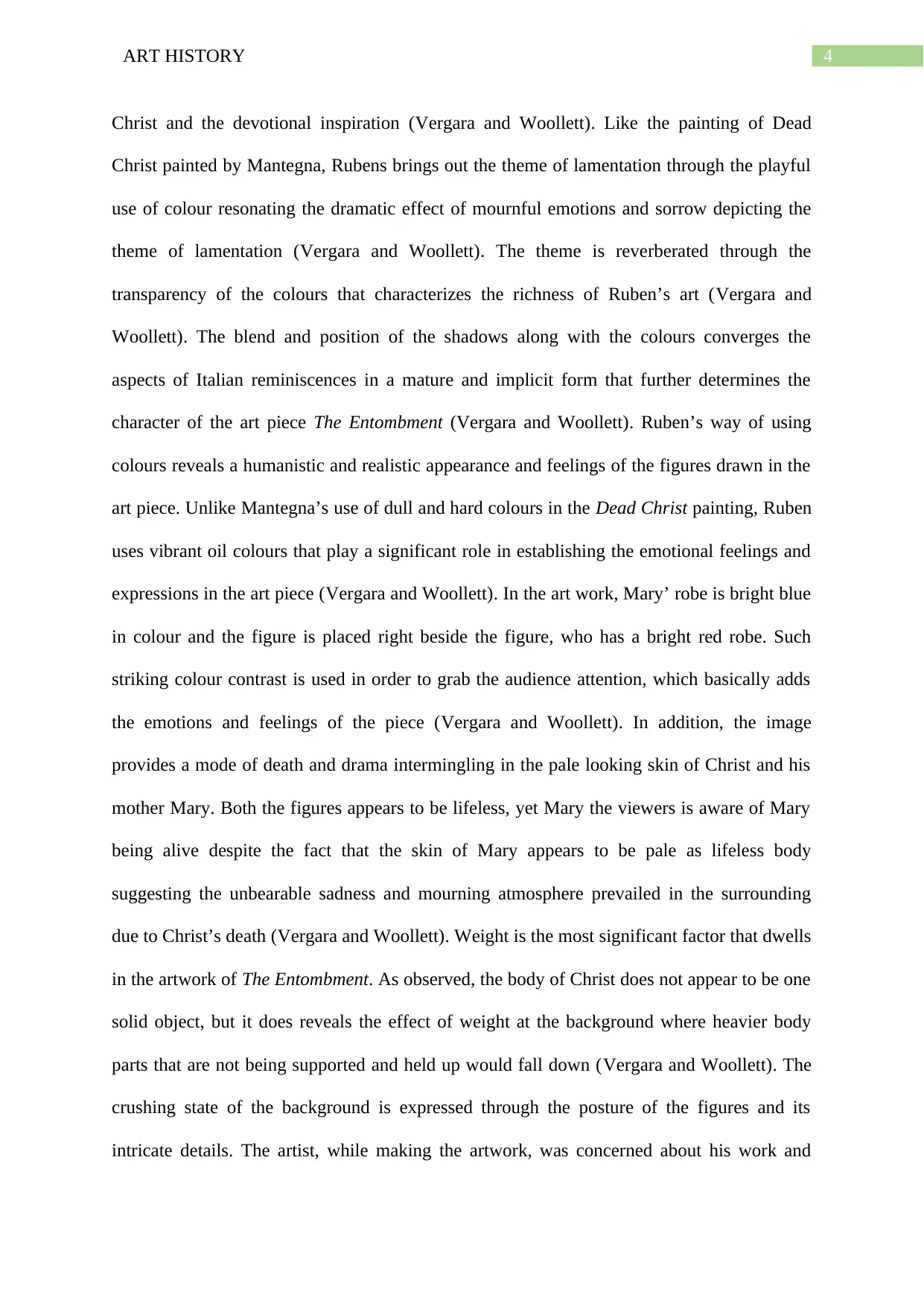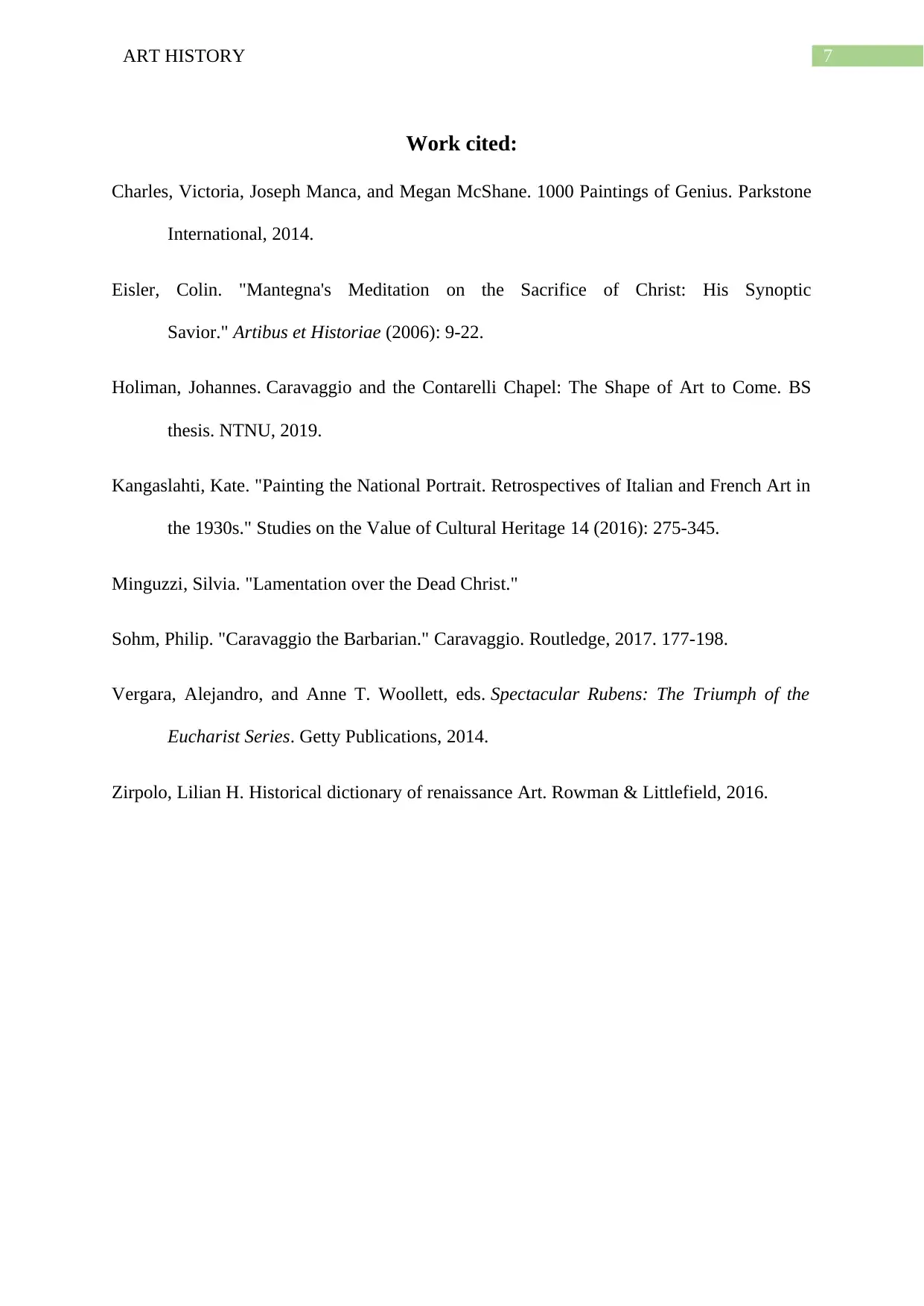Renaissance Lamentation: A Comparative Analysis of Two Masterpieces
VerifiedAdded on 2022/08/15
|8
|2273
|13
Essay
AI Summary
This essay provides a comparative analysis of two significant Renaissance paintings: Andrea Mantegna's 'Dead Christ' and Peter Paul Rubens' 'The Entombment.' The essay explores the artistic techniques, thematic elements, and historical context of each artwork, highlighting the distinct styles of the two artists. It examines Mantegna's innovative use of foreshortening, unconventional color palettes, and the depiction of grief, contrasting these with Rubens' vibrant oil colors, dramatic use of light and shadow, and emphasis on emotional realism. The comparison delves into the artists' treatment of the lamentation theme, the portrayal of figures, and the overall impact on the viewer. The analysis considers the influences of 'Tenebrism' and 'Caravaggism' in Mantegna's work, while also acknowledging the religious undertones and humanistic appearance in Rubens' painting. Ultimately, the essay underscores the unique contributions of Mantegna and Rubens to Renaissance art, demonstrating their mastery in conveying emotional depth, realism, and religious themes through their distinctive artistic approaches. The essay also includes the use of color, composition, and the portrayal of human emotion, offering a comprehensive understanding of these iconic artworks.

Running head: ART HISTORY
ART HISTORY
Name of the Student
Name of the University
Author Note
ART HISTORY
Name of the Student
Name of the University
Author Note
Paraphrase This Document
Need a fresh take? Get an instant paraphrase of this document with our AI Paraphraser

1ART HISTORY
Dead Christ, a painting by the Italian Renaissance artist Andrea Mantegna during
1470s, portrays a cramped body of Christ supine, covered with draped cloth that resonates an
extraordinary intensity of the period. The livid body of Christ lies on red marble base that
represents a relic, the Unction Stone (Minguzzi). The wounds of Christ are clearly exposed.
The mourning figure in the background appears to be hardly visible and is thought to be Mary
Magdalene and the figure that is in the foreground is the Baptist, St. John. The painting with
dark background reveals a strong lightning from the right side (Eisler). The painting appears
to be predominantly dark through the images such as the small chamber that reveals an
aperture of the wall in the background and further it leads to even darker room. The darker
place possibly symbolizes the burial place of Christ (Minguzzi). The innovation in Mantegna
is exposed through the techniques used in the painting of the Dead Christ. The texture and
the innovative exposure of the elegant efforts are revealed through the work (Eisler). The
technique of painting on canvas was not usual in those times. He used a glue-based adhesive
for the oil-based paints instead of mixing it with egg (Minguzzi). The use of such technique,
created a texture of crispness and flatness that is similar to fresco (Eisler). The blend of
matted layer is the final addition that provides an invasive intimacy with much more clarity to
every details in his painting (Minguzzi). The innovative techniques made his work moving
and live, pouring out the emotions and expressions (Eisler). Following it, the art in drawing
out the sadly lined face of Mary is what makes his art looks impressive (Minguzzi).
Mantegna has deliberately chosen the unconventional ways in the making of art. He used
wan, gloomy colours instead of soft colours in order to establish the merciless and bitter
interpretation of the moment or scene revealed in his art (Minguzzi). The most remarkable
and striking aspect of the Dead Christ is the view of foreshortened of Christ’s figure.
Following, the painting is also known as ‘Christ Foreshortened’ (Eisler). Through the use of
foreshortened figure, Mantegna along with providing the realistic interpretation and
Dead Christ, a painting by the Italian Renaissance artist Andrea Mantegna during
1470s, portrays a cramped body of Christ supine, covered with draped cloth that resonates an
extraordinary intensity of the period. The livid body of Christ lies on red marble base that
represents a relic, the Unction Stone (Minguzzi). The wounds of Christ are clearly exposed.
The mourning figure in the background appears to be hardly visible and is thought to be Mary
Magdalene and the figure that is in the foreground is the Baptist, St. John. The painting with
dark background reveals a strong lightning from the right side (Eisler). The painting appears
to be predominantly dark through the images such as the small chamber that reveals an
aperture of the wall in the background and further it leads to even darker room. The darker
place possibly symbolizes the burial place of Christ (Minguzzi). The innovation in Mantegna
is exposed through the techniques used in the painting of the Dead Christ. The texture and
the innovative exposure of the elegant efforts are revealed through the work (Eisler). The
technique of painting on canvas was not usual in those times. He used a glue-based adhesive
for the oil-based paints instead of mixing it with egg (Minguzzi). The use of such technique,
created a texture of crispness and flatness that is similar to fresco (Eisler). The blend of
matted layer is the final addition that provides an invasive intimacy with much more clarity to
every details in his painting (Minguzzi). The innovative techniques made his work moving
and live, pouring out the emotions and expressions (Eisler). Following it, the art in drawing
out the sadly lined face of Mary is what makes his art looks impressive (Minguzzi).
Mantegna has deliberately chosen the unconventional ways in the making of art. He used
wan, gloomy colours instead of soft colours in order to establish the merciless and bitter
interpretation of the moment or scene revealed in his art (Minguzzi). The most remarkable
and striking aspect of the Dead Christ is the view of foreshortened of Christ’s figure.
Following, the painting is also known as ‘Christ Foreshortened’ (Eisler). Through the use of
foreshortened figure, Mantegna along with providing the realistic interpretation and

2ART HISTORY
importance of the Christ’ feet, he also shows the altered reality where the he facial
expressions of the figures are displayed (Minguzzi). The entire art work expresses a
naturalistic representation. The viewpoint angle of the faces of the sadly lined figures is
different from that of Christ’s body in order to reveal the full emotive force of St. John and
Mary’s who are in tears (Eisler). Mantegna broke the traditions and conventions of the period
in order to give the Dead Christ scene a justified texture along with the grief and despair
reverberated through the innovative and unique piece of work (Minguzzi). Moreover,
Mantegna even symbolizes the red marble unction stone providing an enduring appreciation
and celebration of the unction stone that was dear to the Christian pilgrims (Eisler). Mantegna
is the only Renaissance artist who treated the theme of Dead Christ, mourned by his dear
ones and followers providing an even sense of loss the moment when they confront the grief
stricken frightening silence and hollowness of death (Minguzzi). The theme majorly reveals
the lamentation over the dead Christ. In the medieval and Renaissance art, the theme of
lamentation is common but the artist’s treatment of individual identity through his unique art
is unusual (Eisler). The notion of Lamentation is incorporated in order to bring out more
contact between the body and the mourners (Eisler). The emotion of the spectators are clear
provided with shock and intimacy (Minguzzi). The painting also provide a playful contrast of
light and shadow around the figures revealing the profound sense of pathos. The intricate
detailing of the muscles, bones, the facial expressions of the figures provide a stigmatic
sensation and realism (Minguzzi). The drapery that covers the Christ’s body gives an overall
dramatic effect. Through these intricate details, Mantegna paints the scene representing
successfully the emotional and the physical trauma (Minguzzi). The paintings paint the
realism with the use of material and aesthetic aspects of Mantegna’s ideologies of art (Eisler).
It further points out the harmony and the right blend of aesthetic and idealized compositional
importance of the Christ’ feet, he also shows the altered reality where the he facial
expressions of the figures are displayed (Minguzzi). The entire art work expresses a
naturalistic representation. The viewpoint angle of the faces of the sadly lined figures is
different from that of Christ’s body in order to reveal the full emotive force of St. John and
Mary’s who are in tears (Eisler). Mantegna broke the traditions and conventions of the period
in order to give the Dead Christ scene a justified texture along with the grief and despair
reverberated through the innovative and unique piece of work (Minguzzi). Moreover,
Mantegna even symbolizes the red marble unction stone providing an enduring appreciation
and celebration of the unction stone that was dear to the Christian pilgrims (Eisler). Mantegna
is the only Renaissance artist who treated the theme of Dead Christ, mourned by his dear
ones and followers providing an even sense of loss the moment when they confront the grief
stricken frightening silence and hollowness of death (Minguzzi). The theme majorly reveals
the lamentation over the dead Christ. In the medieval and Renaissance art, the theme of
lamentation is common but the artist’s treatment of individual identity through his unique art
is unusual (Eisler). The notion of Lamentation is incorporated in order to bring out more
contact between the body and the mourners (Eisler). The emotion of the spectators are clear
provided with shock and intimacy (Minguzzi). The painting also provide a playful contrast of
light and shadow around the figures revealing the profound sense of pathos. The intricate
detailing of the muscles, bones, the facial expressions of the figures provide a stigmatic
sensation and realism (Minguzzi). The drapery that covers the Christ’s body gives an overall
dramatic effect. Through these intricate details, Mantegna paints the scene representing
successfully the emotional and the physical trauma (Minguzzi). The paintings paint the
realism with the use of material and aesthetic aspects of Mantegna’s ideologies of art (Eisler).
It further points out the harmony and the right blend of aesthetic and idealized compositional
⊘ This is a preview!⊘
Do you want full access?
Subscribe today to unlock all pages.

Trusted by 1+ million students worldwide

3ART HISTORY
aspects (Eisler). With such approaches in painting, Mantegna appeared to be empowering
with moral values.
The Entombment, painted by Peter Paul Ruben, is an oil based painting on canvas
created in the year of around 1612. The painting is recognized as the Baroque style provided
with some mannerist intricate design elements that are incorporated in the painting (Vergara
and Woollett). The art piece depicts the sufferings and grief stricken surroundings dwelling
around the death of Christ (Vergara and Woollett). In the painting, the body of Christ lies
limp across the canvas and is held up and supported by his loved and dear ones and his
followers, who are projected as mournful figures due to the loss of their leader, or rather a
friend (Vergara and Woollett). The painting of Peter Paul Rubens depicted the scene after
crucifixion and before resurrection when Christ was placed in the tomb. The emotional
attachment is expressed with great importance to the church during that time. The painting
contains John in red robe, the figure who bears the major weight of Christ; while Mary
bowing her head in sorrow, cries in the dark background (Vergara and Woollett). The
Entombment signifies the personal religious experience of the viewer and encourages the
potential to imagine the worst or physical horror in the course of Crucifixion of the Christ
(Vergara and Woollett). The wounds as revealed in Mantegna’s Dead Christ, is also exposed,
that is, blood flowing from the gaping laceration in the side of Christ’s body and the other
wound is depicted as punctured on his hands. Rubens brings a striking contrast between the
living and dead measured by the green tinged lifeless body of Christ and healthy complexion
of St. John (Vergara and Woollett). The painting is perhaps dedicated to the Eucharist, also
known as ‘The Last Supper’(Vergara and Woollett). It is a sacrament in the church in which a
prayer or blessing is said to be considered over a mealof wine and bread. The painting was
made by Peter Paul Rubens for an altarpiece inside a Catholic chapel. The intention of the
painting is to serve as a meditational device towards which one focuses on the sufferings of
aspects (Eisler). With such approaches in painting, Mantegna appeared to be empowering
with moral values.
The Entombment, painted by Peter Paul Ruben, is an oil based painting on canvas
created in the year of around 1612. The painting is recognized as the Baroque style provided
with some mannerist intricate design elements that are incorporated in the painting (Vergara
and Woollett). The art piece depicts the sufferings and grief stricken surroundings dwelling
around the death of Christ (Vergara and Woollett). In the painting, the body of Christ lies
limp across the canvas and is held up and supported by his loved and dear ones and his
followers, who are projected as mournful figures due to the loss of their leader, or rather a
friend (Vergara and Woollett). The painting of Peter Paul Rubens depicted the scene after
crucifixion and before resurrection when Christ was placed in the tomb. The emotional
attachment is expressed with great importance to the church during that time. The painting
contains John in red robe, the figure who bears the major weight of Christ; while Mary
bowing her head in sorrow, cries in the dark background (Vergara and Woollett). The
Entombment signifies the personal religious experience of the viewer and encourages the
potential to imagine the worst or physical horror in the course of Crucifixion of the Christ
(Vergara and Woollett). The wounds as revealed in Mantegna’s Dead Christ, is also exposed,
that is, blood flowing from the gaping laceration in the side of Christ’s body and the other
wound is depicted as punctured on his hands. Rubens brings a striking contrast between the
living and dead measured by the green tinged lifeless body of Christ and healthy complexion
of St. John (Vergara and Woollett). The painting is perhaps dedicated to the Eucharist, also
known as ‘The Last Supper’(Vergara and Woollett). It is a sacrament in the church in which a
prayer or blessing is said to be considered over a mealof wine and bread. The painting was
made by Peter Paul Rubens for an altarpiece inside a Catholic chapel. The intention of the
painting is to serve as a meditational device towards which one focuses on the sufferings of
Paraphrase This Document
Need a fresh take? Get an instant paraphrase of this document with our AI Paraphraser

4ART HISTORY
Christ and the devotional inspiration (Vergara and Woollett). Like the painting of Dead
Christ painted by Mantegna, Rubens brings out the theme of lamentation through the playful
use of colour resonating the dramatic effect of mournful emotions and sorrow depicting the
theme of lamentation (Vergara and Woollett). The theme is reverberated through the
transparency of the colours that characterizes the richness of Ruben’s art (Vergara and
Woollett). The blend and position of the shadows along with the colours converges the
aspects of Italian reminiscences in a mature and implicit form that further determines the
character of the art piece The Entombment (Vergara and Woollett). Ruben’s way of using
colours reveals a humanistic and realistic appearance and feelings of the figures drawn in the
art piece. Unlike Mantegna’s use of dull and hard colours in the Dead Christ painting, Ruben
uses vibrant oil colours that play a significant role in establishing the emotional feelings and
expressions in the art piece (Vergara and Woollett). In the art work, Mary’ robe is bright blue
in colour and the figure is placed right beside the figure, who has a bright red robe. Such
striking colour contrast is used in order to grab the audience attention, which basically adds
the emotions and feelings of the piece (Vergara and Woollett). In addition, the image
provides a mode of death and drama intermingling in the pale looking skin of Christ and his
mother Mary. Both the figures appears to be lifeless, yet Mary the viewers is aware of Mary
being alive despite the fact that the skin of Mary appears to be pale as lifeless body
suggesting the unbearable sadness and mourning atmosphere prevailed in the surrounding
due to Christ’s death (Vergara and Woollett). Weight is the most significant factor that dwells
in the artwork of The Entombment. As observed, the body of Christ does not appear to be one
solid object, but it does reveals the effect of weight at the background where heavier body
parts that are not being supported and held up would fall down (Vergara and Woollett). The
crushing state of the background is expressed through the posture of the figures and its
intricate details. The artist, while making the artwork, was concerned about his work and
Christ and the devotional inspiration (Vergara and Woollett). Like the painting of Dead
Christ painted by Mantegna, Rubens brings out the theme of lamentation through the playful
use of colour resonating the dramatic effect of mournful emotions and sorrow depicting the
theme of lamentation (Vergara and Woollett). The theme is reverberated through the
transparency of the colours that characterizes the richness of Ruben’s art (Vergara and
Woollett). The blend and position of the shadows along with the colours converges the
aspects of Italian reminiscences in a mature and implicit form that further determines the
character of the art piece The Entombment (Vergara and Woollett). Ruben’s way of using
colours reveals a humanistic and realistic appearance and feelings of the figures drawn in the
art piece. Unlike Mantegna’s use of dull and hard colours in the Dead Christ painting, Ruben
uses vibrant oil colours that play a significant role in establishing the emotional feelings and
expressions in the art piece (Vergara and Woollett). In the art work, Mary’ robe is bright blue
in colour and the figure is placed right beside the figure, who has a bright red robe. Such
striking colour contrast is used in order to grab the audience attention, which basically adds
the emotions and feelings of the piece (Vergara and Woollett). In addition, the image
provides a mode of death and drama intermingling in the pale looking skin of Christ and his
mother Mary. Both the figures appears to be lifeless, yet Mary the viewers is aware of Mary
being alive despite the fact that the skin of Mary appears to be pale as lifeless body
suggesting the unbearable sadness and mourning atmosphere prevailed in the surrounding
due to Christ’s death (Vergara and Woollett). Weight is the most significant factor that dwells
in the artwork of The Entombment. As observed, the body of Christ does not appear to be one
solid object, but it does reveals the effect of weight at the background where heavier body
parts that are not being supported and held up would fall down (Vergara and Woollett). The
crushing state of the background is expressed through the posture of the figures and its
intricate details. The artist, while making the artwork, was concerned about his work and

5ART HISTORY
focused to make it look more nature and realistic. Thereby, the human-like feeling is exposed
in the piece (Vergara and Woollett).
When comparing Rubens’ The Embodiment to Mantegna’s Dead Christ which are
painted on canvas, provides the notions of variant techniques used in their unique and
innovative way. Both Mantegna and Rubens use colours to reveal death, but Mantegna’s use
of colour is exaggerated by using the glue based oil paint that would stay fixated providing a
coarse texture pointing out the harsh reality and the sorrowful atmosphere of the scene.
Mantegna’s use of pale colour suggests the gloomy surrounding due to Christ’s death
(Minguzzi). The appearance also indicates the decaying tinge of Christ body and the fact that
he had been dead for a long time. Whereas, Rubens use of colour provides more naturalistic
appearance of the skin tone and further makes it appear as if Christ had just died (Vergara
and Woollett). The fact that the artists being hailed from different centuries, it is evident both
of their works provide realistic features to move the viewers. Mantegna appears to use dark
colours bringing out the characteristic of ‘Tenebrism’ and ‘Caravaggism’ that has been
incorporated in the most spectacular way and the positioning of light coming from a
particular area also gives an intense effect in the painting with predominant trait of darkness
(Minguzzi). Whereas Rubens uses of bright colours and tenebrism provides a divine lighting
effect that adds a religious tone to the scene. The major element of these artworks lies in the
face (Vergara and Woollett). Rubens piece focuses to provide natural detail in the faces
maintaining an undertone of sadness throughout every figures incorporated. While in
Mantegna’s work, the focus on the faces of St. John and Mary highlights the extreme grief
with total disbelief. Both the artists reveal the theme of lamentation in their own unique and
innovative style of painting. They accomplished in bringing out the realistic features of the
figures by adding natural approach in the details. An approach that bounded the audience’s
focused to make it look more nature and realistic. Thereby, the human-like feeling is exposed
in the piece (Vergara and Woollett).
When comparing Rubens’ The Embodiment to Mantegna’s Dead Christ which are
painted on canvas, provides the notions of variant techniques used in their unique and
innovative way. Both Mantegna and Rubens use colours to reveal death, but Mantegna’s use
of colour is exaggerated by using the glue based oil paint that would stay fixated providing a
coarse texture pointing out the harsh reality and the sorrowful atmosphere of the scene.
Mantegna’s use of pale colour suggests the gloomy surrounding due to Christ’s death
(Minguzzi). The appearance also indicates the decaying tinge of Christ body and the fact that
he had been dead for a long time. Whereas, Rubens use of colour provides more naturalistic
appearance of the skin tone and further makes it appear as if Christ had just died (Vergara
and Woollett). The fact that the artists being hailed from different centuries, it is evident both
of their works provide realistic features to move the viewers. Mantegna appears to use dark
colours bringing out the characteristic of ‘Tenebrism’ and ‘Caravaggism’ that has been
incorporated in the most spectacular way and the positioning of light coming from a
particular area also gives an intense effect in the painting with predominant trait of darkness
(Minguzzi). Whereas Rubens uses of bright colours and tenebrism provides a divine lighting
effect that adds a religious tone to the scene. The major element of these artworks lies in the
face (Vergara and Woollett). Rubens piece focuses to provide natural detail in the faces
maintaining an undertone of sadness throughout every figures incorporated. While in
Mantegna’s work, the focus on the faces of St. John and Mary highlights the extreme grief
with total disbelief. Both the artists reveal the theme of lamentation in their own unique and
innovative style of painting. They accomplished in bringing out the realistic features of the
figures by adding natural approach in the details. An approach that bounded the audience’s
⊘ This is a preview!⊘
Do you want full access?
Subscribe today to unlock all pages.

Trusted by 1+ million students worldwide

6ART HISTORY
attention and emotions and has further introduced a traditional and religious iconic image into
a new light and perspective.
attention and emotions and has further introduced a traditional and religious iconic image into
a new light and perspective.
Paraphrase This Document
Need a fresh take? Get an instant paraphrase of this document with our AI Paraphraser

7ART HISTORY
Work cited:
Charles, Victoria, Joseph Manca, and Megan McShane. 1000 Paintings of Genius. Parkstone
International, 2014.
Eisler, Colin. "Mantegna's Meditation on the Sacrifice of Christ: His Synoptic
Savior." Artibus et Historiae (2006): 9-22.
Holiman, Johannes. Caravaggio and the Contarelli Chapel: The Shape of Art to Come. BS
thesis. NTNU, 2019.
Kangaslahti, Kate. "Painting the National Portrait. Retrospectives of Italian and French Art in
the 1930s." Studies on the Value of Cultural Heritage 14 (2016): 275-345.
Minguzzi, Silvia. "Lamentation over the Dead Christ."
Sohm, Philip. "Caravaggio the Barbarian." Caravaggio. Routledge, 2017. 177-198.
Vergara, Alejandro, and Anne T. Woollett, eds. Spectacular Rubens: The Triumph of the
Eucharist Series. Getty Publications, 2014.
Zirpolo, Lilian H. Historical dictionary of renaissance Art. Rowman & Littlefield, 2016.
Work cited:
Charles, Victoria, Joseph Manca, and Megan McShane. 1000 Paintings of Genius. Parkstone
International, 2014.
Eisler, Colin. "Mantegna's Meditation on the Sacrifice of Christ: His Synoptic
Savior." Artibus et Historiae (2006): 9-22.
Holiman, Johannes. Caravaggio and the Contarelli Chapel: The Shape of Art to Come. BS
thesis. NTNU, 2019.
Kangaslahti, Kate. "Painting the National Portrait. Retrospectives of Italian and French Art in
the 1930s." Studies on the Value of Cultural Heritage 14 (2016): 275-345.
Minguzzi, Silvia. "Lamentation over the Dead Christ."
Sohm, Philip. "Caravaggio the Barbarian." Caravaggio. Routledge, 2017. 177-198.
Vergara, Alejandro, and Anne T. Woollett, eds. Spectacular Rubens: The Triumph of the
Eucharist Series. Getty Publications, 2014.
Zirpolo, Lilian H. Historical dictionary of renaissance Art. Rowman & Littlefield, 2016.
1 out of 8
Your All-in-One AI-Powered Toolkit for Academic Success.
+13062052269
info@desklib.com
Available 24*7 on WhatsApp / Email
![[object Object]](/_next/static/media/star-bottom.7253800d.svg)
Unlock your academic potential
Copyright © 2020–2025 A2Z Services. All Rights Reserved. Developed and managed by ZUCOL.
